#gustav x frederic
Text










I WISH THAT I’D BEEN BRAVE.
richard siken, crush // christopher healy, a hero’s guide to saving your kingdom // the amazing devil, ruin // j.d. salinger, raise the high roof beam // susan sontag, as consciousness is harnessed to flesh: journals and notebooks // claudia rankine, don’t let me be lonely: an american lyric // the avett brothers, i wish i was // frank bidart, the war of vaslav nijinsky // nicola toon, everything, everything
#web weaving#parallels#word collage#i’m going insane#words#on guilt#guilt#the avett brothers#susan sontag#the amazing devil#richard siken#hero’s guide#hero’s guide to saving your kingdom#this one’s for the frederic x gustav girlies !!#gustav x frederic#christopher healy#i’ve been trying to make this for awhile and it’s all come together :)#nicola yoon#everything everything#claudia rankine
5K notes
·
View notes
Text
normalize shipping in a way where you can't actually picture the characters ever getting together there's just definitely something going on there
4 notes
·
View notes
Photo

Madame Frederic Breyer (Fanny Hélène Van Bruyssel, 1830–1894), Gustave Courbet, 1858, European Paintings
H. O. Havemeyer Collection, Bequest of Mrs. H. O. Havemeyer, 1929
Size: 36 x 28 5/8 in. (91.4 x 72.7 cm)
Medium: Oil on canvas
https://www.metmuseum.org/art/collection/search/436000
7 notes
·
View notes
Photo
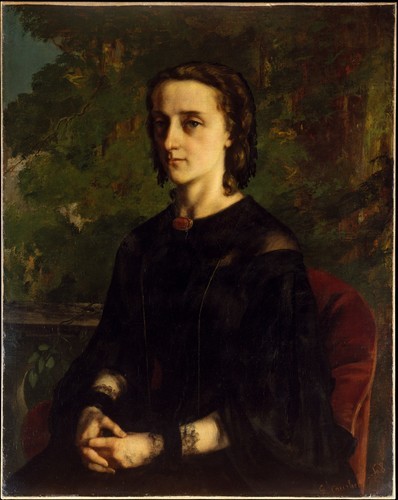
Madame Frederic Breyer (Fanny Hélène Van Bruyssel, 1830–1894), Gustave Courbet, 1858, European Paintings
H. O. Havemeyer Collection, Bequest of Mrs. H. O. Havemeyer, 1929
Size: 36 x 28 5/8 in. (91.4 x 72.7 cm)
Medium: Oil on canvas
https://www.metmuseum.org/art/collection/search/436000
3 notes
·
View notes
Photo
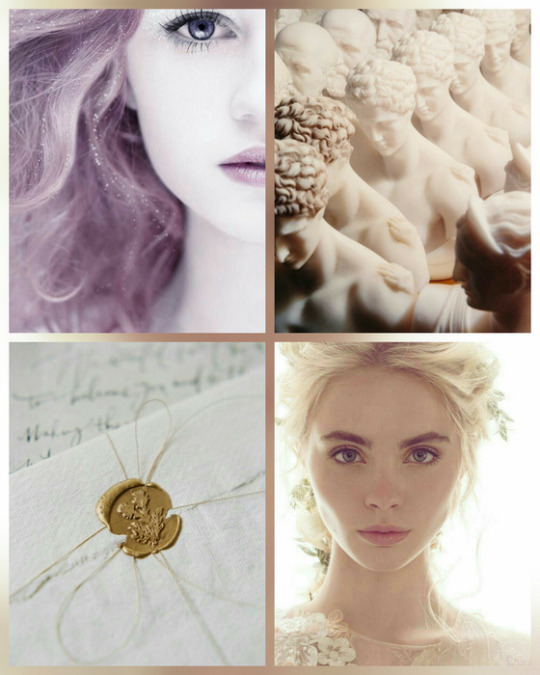
House Aesthetic + Mini-Playlist
Classical Hufflepuff
1. Erik Satie - Gnossienne No. 1, 2, 3 (x)
2. Frederic Chopin - Nocturne No.20 in C-Sharp minor (x)
3. Arvo Pärt - Fur Alina (x)
4. Gustav Mahler - Adagietto Symphony No. 5 (x)
5. Maurice Ravel - Pavane for Dead Princess (x)
41 notes
·
View notes
Text
Kiss a Ginger Day

It’s Kiss a Ginger day and we’re kicking off the day by celebrating redheads in art history. Like this painting of two lovers in Gustav Klimt’s The Kiss in the Austrian Gallery at Belvedere, appreciation of ginger beauties and their glorious red locks can be spotted throughout Art History. Here are the most glamorous redheads of art history.

Starting off the list of famous redheads in Art History is Bottecelli’s redhead that is the literal embodiment of beauty as the goddess Venus.

Birth of Venus by Sandro Boticelli at the Uffizi Gallery
The next babe with flaming tresses and the sheer outfit to match is Frederic Leighton’s Flaming June. The model for this painting was probably Dorothy Dene or Mary Lloyd, either way she is living her best life getting paid to sleep on the job.
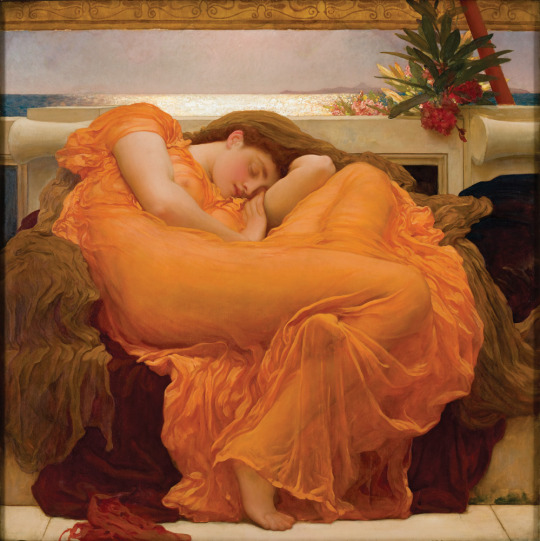
Flaming June by Frederic Leighton at the Art Museum of Ponce
Number 3 on our list is the artist Van Gogh himself in a selfie with reddish orange hair highlighted against the blue-green background. The man knew his complimentary colors.

Self-Portrait by Vincent van Gogh at the Musée d’Orsay
Our next ginger vixen is depicted raising a toast to her lover off to war. Or perhaps it’s a cheers to the haters slandering gingers.

The Loving Cup by Dante Gabriel Rosetti at the National Museum of Western Art
Causing quite the controversy during her debut is Sargent’s Madame X. Originally featured with a fallen strap, critics were so harsh about that bare shoulder that Sargent was forced to go into hiding.

Madame X by John Singer Sargent at the Metropolitan Museum of Art
Next up is Louise Webber in Toulouse-Lautrec’s The Glutton at the Moulin Rouge. Known for her wild moves and sometimes transparent outfits, fierce is an understatement when describing this woman.

The Glutton at the Moulin Rouge by Henri de Toulouse-Lautrec at the Museum of Modern Art
Egon Schiele, Klimt’s protégé, dated so many redheads that we’re not sure which one is depicted here in this painting.
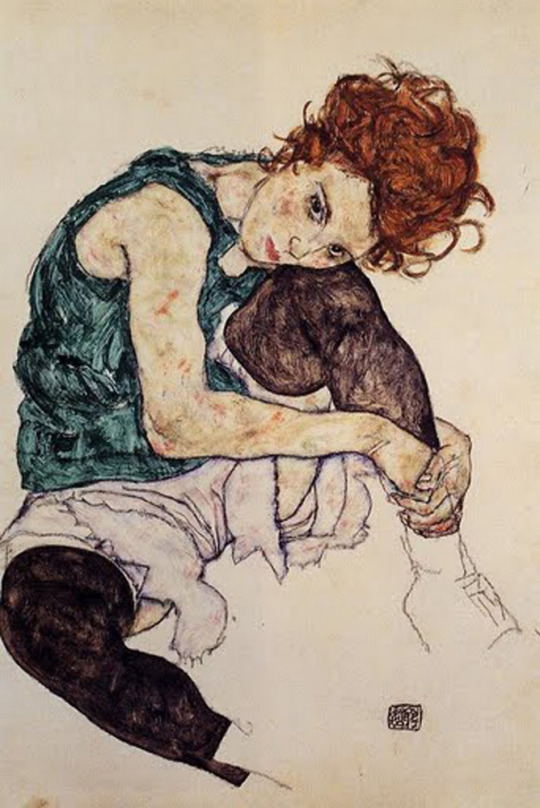
Seated Woman with Bent Knee by Egon Schiele at the National Gallery in Prague
Number 8 features contemporary artist Thomas Darsney’s redhead in Tapestry.
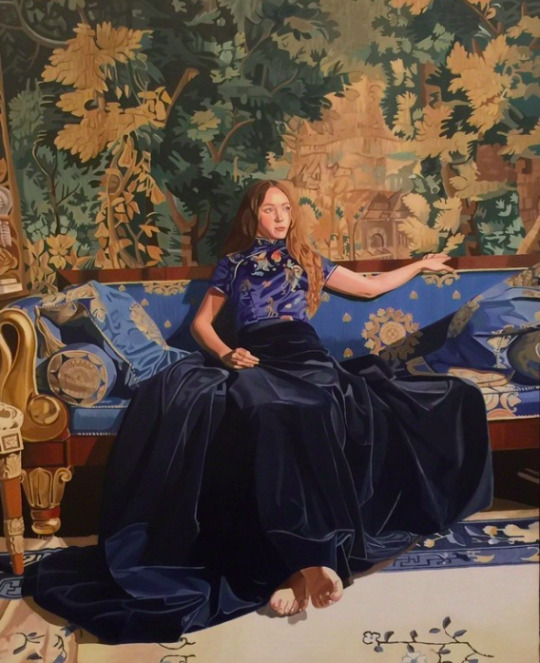
Tapestry by Thomas Darsney in a Private Collection via Artsy
Modigliani painted an inquisitive figure in his Young Man with Red Hair. Turns out it’s much harder to find men with red hair in art history than female redheads.

Young Man with Red Hair by Amedeo Modigliani at the Tate
Last but not least is Francesco Bacchiacca’s Sibyl with the not-so-subtle nip slip. Apparently Sibyl is also a fan of the transparent clothing making her third on our list of Art History redheads who love sheer clothing.

Sibyl by Francesco Bacchiacca at the Museum of Art History Vienna
By: Akhadka
#kiss a ginger day#art history#art#redheads#ginger#amedeo modigliani#sandro botticelli#francesco bacchiacca#egon schiele#vincent van gogh#henri de toulouse-lautrec#john singer sargent#frederic leighton#dante gabriel rossetti#very silly#fun stuff
1 note
·
View note
Text
Diane von Furstenberg Uses AR to Throw World’s Largest Launch Party
Diane von Furstenberg knows how to throw a launch party. In this case, the famous designer is inviting a billion people to celebrate the opening of the new Statue of Liberty Museum. “The goal was to make this the biggest opening of a museum ever,” she said at a prelaunch gathering in New York yesterday.
Considering the island where the museum and iconic statue are situated is only about 14 acres, she required a little assistance from Apple to make that happen. In addition to helping raise $100,000 million to build the museum, which opens this Thursday (May 16), von Furstenberg asked Tim Cook to create an “Apple experience.”
“I didn’t know what I was saying when I asked him that,” she laughs. “But the AR experience [they created] is pretty amazing. Now anyone in the world with an iPhone or iPad can access the museum.”
The Statue of Liberty app, which was developed by Yap Studios using the Apple ARKit, has three AR experiences. Torch Panorama transports you to the top of the statue—a vantage point that IRL hasn’t been open to people since 1916—and gives you a view of the island and the city from sunrise to sunset.
Making of the Lady Liberty zooms in on the statue, which was created by French sculptor Frederic Bartholdi and brought to American in 1885. You can see how it’s aged over the years from its coppery orange to green. In x-ray mode you can tour inside to see the iron tower that Gustav Eiffel created to hold the structure together. You can also transport (Pokémon-style) a life-sized model of the statue’s foot anywhere in the world.
The Historical Time-lapse shows how the city’s skyline and harbour has changed over the past 200 years. In addition to its immersive features, you can also learn about the statue’s storied history. If you’re one of the 4.5 million people who visit the island each year, you can use the app to access an audio tour and map as well as listen to a three-part podcast created by Frqncy Media called “Raising the Torch,” which explores the concept of liberty and is narrated by von Furstenberg.
Her own history with the statue dates back to the time her parents were visiting New York and sent her a postcard of Lady Liberty. The next time she saw it was from the vantage point similar to thousands of other immigrants who arrived in the New York harbour by boat. She was 22 and moving from Belgium to New York to join her then husband, Prince Egon von Furstenberg.
“Other than those two occasions, she [the statue] didn’t really mean anything to me until I got involved with the project and really dug into its history,” von Furstenberg said. Getting involved, however, took some convincing. Stephen Briganti, the president and CEO of The Statue of Liberty-Ellis Island Foundation, had asked her repeatedly but she always said her husband would divorce her if she joined another board. She had sent Briganti a copy of her book, “The Woman I Wanted to Be” not knowing that this would seal the deal.
“He read the book and underlined something my mother had written,” she recalled. “My mother was in a concentration camp for 13 months; she survived and I was born after. She wrote me a note, which I wrote in my book, in which she said, ‘God saved me so that I could give you life. By giving you life, you gave me my life back. You are my torch of freedom.’ Steve underlined that and said ‘Your mother said you were the torch of freedom, you have to do this.’”
The post Diane von Furstenberg Uses AR to Throw World’s Largest Launch Party appeared first on FASHION Magazine.
Diane von Furstenberg Uses AR to Throw World’s Largest Launch Party published first on https://borboletabags.tumblr.com/
0 notes
Text
The Art Institute of Chicago Now Offers Unrestricted Access to over 52,000 High-Resolution Images from Their Collection
Georges Seurat,” A Sunday on La Grande Jatte — 1884″ (1884–8), oil on canvas, 81 3/4 x 121 1/4 inches (image courtesy Helen Birch Bartlett Memorial Collection)
The Art Institute of Chicago recently announced the release of tens of thousands of images from their collection to the public domain, providing high resolution access to the thick paint strokes of Van Gogh’s “The Bedroom,” the eerie light of Edvard Munch’s “The Girl by the Window,” or the pointillism used in George Seurat’s famous “A Sunday on La Grande Jatte — 1884.″ The works have been made available under the Creative Commons Zero (CC0) license, which presents the works without copyright. Visitors to the Art Institute’s website also can experience enhanced viewing for each image by zooming in on the paintings, drawings, and other artworks with more detail than before. The current image count is at 53,438, however the Art Institute explains that this number will continue to expand regularly. (via Hyperallergic)
Vincent van Gogh, “The Bedroom” (1888), oil on canvas, 29 x 36 5/8 inches (image courtesy Helen Birch Bartlett Memorial Collection)
Gustave Caillebotte, “Paris Street; Rainy Day” (1877), oil on canvas, 83 1/2 x 108 3/4 in, (image courtesy Charles H. and Mary F. S. Worcester Collection)
Edvard Munch, “The Girl by the Window” (1893), oil on canvas, 38 × 25 3/4 inches (image courtesy Searle Family Trust and Goldabelle McComb Finn endowments; Charles H. and Mary F.S. Worcester Collection)
Katsushika Hokusai, “Under the Wave off Kanagawa (Kanagawa oki nami ura), also known as the Great Wave, from the series “Thirty-six Views of Mount Fuji (Fugaku sanjurokkei)” (c. 1830/33), Color woodblock print, 10 x 14 3/4 in (courtesy of Clarence Buckingham Collection)
Charles White, “Harvest Talk” (1953), charcoal, Wolff’s carbon drawing pencil, and graphite, with stumping and erasing on ivory wood pulp laminate board, 661 x 992 mm (courtesy of Mr. and Mrs. Robert S. Hartman)
Georgia O’Keeffe, “Cow’s Skull with Calico Roses” (1931), oil on canvas, 36 × 24 in. (image courtesy Alfred Stieglitz Collection, gift of Georgia O’Keeffe)
Piet Mondrian, “Lozenge Composition with Yellow, Black, Blue, Red, and Gray” (1921), oil on canvas, 60 x 60 cm (image gift of Edgar Kaufmann, Jr.)
David Hockney, “American Collectors (Fred and Marcia Weisman)” (1968), acrylic on canvas (courtesy of Mr. and Mrs. Frederic G. Pick)
from Colossal https://ift.tt/2SsWP4q
via IFTTT
0 notes
Text
10 Classical Compositions that Anime Loves
For anime soundtracks, Western classical music can be a useful tool. One fewer cue to compose, for starters, and you don’t have to navigate the same rights issues that crop up when licensing contemporary music. Especially for more well-known pieces, there might be dozens of different recordings to choose from for just the right interpretation. Audience recognition helps too - there’s something special about hearing a familiar tune played over a pivotal scene. It’s not always used well (I can think of some very, very bad examples), but when smartly inserted, Western music can make for some truly iconic moments. Let’s take a look at some pieces that show up often in anime.
10. Polovtsian Dances from Prince Igor (Alexander Borodin)
youtube
[Pittsburgh Symphony Orchestra]
Although Borodin never finished the opera Prince Igor before his death in 1887, the Polovtsian Dances from the end of Act II survive in concert halls worldwide, as well as in pop culture. No. 17, “Gliding Dance of the Maidens,” appears in Kare Kano: His and Her Circumstances, as well as in the second season of Sound! Euphonium arranged for concert band. The piece itself comes from the scene in Prince Igor where the invading Turkic tribe celebrates the khan Konchak. It was intended to sound exotic when contrasted with the Russian folk music associated with the opera’s protagonists. The piece suggests another land, different and unknowable - appropriate for the finale of Blood Blockade Battlefront, when the supernatural world threatens to collide with the real one. It’s also frequently used in RahXephon to represent the Mulians, a mysterious race that controls music-powered clay mechs. Yoko Kanno even quotes its melody in “Garden of Everything,” the B-side of the movie’s ending theme. In both BBB and RahXephon, the Polovtsian Dances’ ‘foreignness’ emphasizes the long history behind their respective supernatural beings. It’s nice when soundtracks are thematically relevant like that!
9. Symphony No. 8 “Symphony of a Thousand” (Gustav Mahler)
youtube
While not as pervasive in anime as some of the other entries on this list, Mahler 8 (dubbed “Symphony of a Thousand” for its enormous orchestra and chorus) is still pretty iconic, figuring heavily in the broadcast order finale of The Melancholy of Haruhi Suzumiya (chronologically episode 6). The text of the piece itself revolves around redemption through love and confidence in humanity, making the symphony possibly one of the most uplifting pieces of late Romanticism. It’s fitting for a grand finale that [spoilers?] hinges on Haruhi and Kyon’s faith in humanity to keep reality from collapsing. No matter how unusual or interesting Haruhi’s alternate world may be, it’s solitary and miserable. To keep Haruhi from remaking reality according to her own whims, Kyon reminds her of the relationships she’d lose in hopes of grounding her enough to return them to reality. Who cares about a fun fantasy world without people to enjoy it with? Why reject everyone you love in favor of danger and uncertainty? Symphony of a Thousand is ultimately about embracing the human attachments we form, perfectly in line with the anime’s themes.
8. Nocturne Op. 9 No. 2 (Frederic Chopin)
youtube
[official? rubinstein]
A mainstay in film and TV, this nocturne is probably one of the first pieces people associate with Romantic keyboard music. It’s a go-to cue to telegraph that a character is sophisticated: Austria in Hetalia, one of the antagonists in Parasyte -the maxim-; Glasslip, Legend of Galactic Heroes, Momoiro Sisters, the list goes on. So it’s a nice change of pace when it’s used differently, like in the penultimate episode of Hybrid x Heart Magias Academy Ataraxia. The pairing of sweet evening music with a scene of busty, half-naked anime girls fighting to keep Tokyo from blowing up is hilariously jarring - just the way I like my fanservice anime. It’s totally in character for Hybrid x Heart to shoot for drama and blow straight into camp, and the scene is perhaps the best example of that tonal mismatch in the show’s entire run. I’m not sure how the impossibly shy Chopin would feel about his music being used this way, but hey, it’s not like he’s around to complain.
7. Prelude No. 1 from Well-Tempered Clavier (J.S. Bach) / “Ave Maria” (Charles Gounod)
youtube
The Well-Tempered Clavier, composed around 1722 to show off the latest advances in proto-piano technology, is today regarded as one of the Baroque period’s most important works, such that the dozens of preludes and fugues collected in two volumes are the bane of every piano student ever. But while most of WTC is unknown to people outside the music world, the first prelude remains Bach’s most well-known solo keyboard piece (the famous Minuet in G being the work of one of his colleagues). Over a century later, French operatist Charles Gounod superimposed a melody on it, eventually pairing it with the text of a Catholic prayer. The resulting song is about as famous as the original prelude, showing up all over popular culture. Puella Magi Madoka Magica, for an easy anime example. Yurikuma Arashi uses the piece as well, associating it with the bear deity Kumaria (the Virgin Beary, if you will). Yes, you read that right. “Ave Maria” for Kumaria. On the nose? Absolutely. Dead on the fuzzy little bear-girl nose. To be fair, none of the visual metaphors in Yurikuma are any more subtle, so it totally fits. Bless this show.
6. Sonata for Two Pianos in D major, K.448 (W.A. Mozart)
youtube
How do you depict a relationship between two musicians? In a duet, of course! It happens plenty in Your Lie in April in both four-hand piano and violin/piano combinations. But why restrict yourself to one piano when you can have two? That’s where Mozart’s K.448 comes in. When he was 25, he composed the two-piano sonata for a joint performance with his 23-year-old student Josepha Auernhammer, who was purportedly in love with him. Although nothing came of that relationship, the circumstances surrounding the piece’s composition perhaps make it tempting to assign romantic connotations to any performance of it. Certain anime take advantage of that: in Ouran High School Host Club (after Tamaki’s bizarre solo demonstration of both parts at once), a duo of middle schoolers learns the two-piano sonata to kick off their blossoming romance. In all versions of Nodame Cantabile, it’s the first collaboration the uptight Chiaki and carefree Nodame undertake together. Handing off the melody between them, Nodame and Chiaki must learn to respect and accomodate their conflicting personalities. It’s important that neither part is simply accompaniment to the other; unlike in a four-hand duet, where one person plays in the lower range and the other in the higher, the two players in a duo must be equally skilled, complementing each other rather than dominating. Chiaki and Nodame’s successful performance of the piece signals their mutual understanding of each other, the start of a complicated but enduring romance/friendship that carries through the rest of the series.
5. “Vocalise,” Op. 34 No. 14 (Sergei Rachmaninoff)
youtube
(unknown, but official upload)
“Vocalise,” as its title suggests, is one of 14 songs that Rachmaninoff originally composed for voice with piano accompaniment. These days, it’s often performed by an orchestra or a solo instrument. I have a particular fondness for Rach’s own orchestral arrangement, but the melody on its own is lovely as well. Melancholic and gorgeous, it suggests a profound loneliness. No wonder it tends to show up in heartwrenching anime scenes. In Puella Magi Madoka Magica, a recording of Kyousuke’s violin solo is yet another contributor to Sayaka’s despair. In Night Raid 1931, the piece is a running motif in spy Aoi Miyoshi’s troubled life, first as a joke about his poor violin skills, and then later as a prominent element in his backstory. His attachment to the piece turns out to be in remembrance of a lost love. It’s an expression of nostalgia to a time when his life was simpler, before Japan’s growing militarism erupted full force in Nanking and Korea, complicating his espionage work. The piece’s presence throughout the series in stilted, off-key form is so essential in making the final revelation land, music reaching clarity just as Miyoshi’s motivations do. It’s one of the best creative choices in a politically controversial but otherwise unremarkable anime, and Miyoshi’s story wouldn’t work nearly as well without it.
4. Piano Concerto No. 2 Op. 18 (Sergei Rachmaninoff)
youtube
I just mentioned a Rachmaninoff piece, but this one is too good to skip. One of the most notoriously difficult and exhausting pieces in the piano repertoire, Rachmaninoff’s second concerto (affectionately nicknamed “Rach 2”) is a perennial concert favorite. The technical skill and strength required to play the entire thing make it a survival challenge in itself. As such, it’s the highlight of the debuts of both Eugenie Danglars in Gankutsuou and Shinichi Chiaki in Nodame Cantabile. It also shows up in Fairy Tail underscoring the climactic fight between Erza and Azuma in episode 114. Throughout the development, Jellal reassures Erza that he’s supporting her in spirit. The music is well-matched to the action onscreen, reaching the virtuosic climax of the first movement at the decisive moment of the battle. As the final chords land, Erza regains her drive. The show does cut some of the tense buildup that I love Rach 2 for, but nonetheless, the payoff is still damn satisfying.
(On the subject of Rachmaninoff, his third piano concerto - my favorite piece of his - shows up markedly less often; the only anime example I can think of is in Legend of the Galactic Heroes. Maybe someday people will understand the glory of Rach 3. In the meantime, try humming the James Bond theme over Rach 2. It’s a lot of fun, I promise.)
3. Etude Op. 10 No. 3, “Tristesse” (Frederic Chopin)
youtube
Today, Chopin’s etudes (Op. 10 and 25) are staples of piano repertoire. Each is a study in a specific keyboard technique. The third etude “Tristesse” (sometimes “L’Adieu”), as it’s now known, emphasizes balance and smooth voicing. The melody - Chopin’s most beautiful, by his own judgment - is still beloved today. It can be heard in the Baccano! finale, as well as in Fullmetal Alchemist (2003) under the title “Tune of Separation,” arranged for string orchestra by Michiru Oshima. My favorite use of it is in the Genius Party short Baby Blue, directed by Shinichiro Watanabe. In the 15-minute film, the melody first appears when Shou sketches out an aimless tune on the piano. It comes back in full force in the dreamlike emotional climax, expressing the bittersweet nostalgia of youth as his childhood friend Hazuki bids him a final farewell. The piece may not have been composed with a narrative in mind, but its reputation as a piece about goodbyes serves it well here in one truly memorable scene.
2. “Clair de lune” from Suite bergamasque (Claude Debussy)
youtube
The third movement of Debussy’s Suite bergamasque, “Clair de lune” is one of the most iconic keyboard pieces in French Impressionism, a late 19th-/early 20th-century artistic movement that prioritized conveying a mood over presenting a detailed picture. That focus on atmosphere over a defined melody might be what makes the piece so appealing as a soundtrack. Its sentimental A-section appears in Kids on the Slope, Wandering Son, 18if, and even an inconsequential bath scene in Thermae Romae. Rarely, however, does anything use the entire piece - which means it stands out all the more in Your Lie in April. In episode 15, the piece perfectly underscores Tsubaki’s nighttime heart-to-heart with Kousei. Her lines are timed to match the piece’s phrasing, and as the music becomes more intense, so does her monologue. The flowing B-section expresses her desperation as she realizes that Kousei’s musical career is taking him out of her reach. By the time Kousei reaches the piece’s recap, we get the sense that something has changed. Tsubaki might be the same person she’s always been, but her relationships have been forever altered. Likewise, the last section of the piece sounds similar to the beginning, but elements of the B-section still linger as a reminder that things can’t stay the same. The scene is a pitch-perfect marriage of story and soundtrack, and my favorite use of “Clair de lune” in anything, full stop.
1. Symphony No. 9, “Choral” (Ludwig van Beethoven)
youtube
Generally agreed to be Beethoven’s greatest work, Beethoven 9 was unique for Classical-era music in that it introduced a chorus layered over the orchestra - hence the nickname. The symphony is an easy go-to for a grandiose and triumphant score, since the “Ode to Joy” melody from the last movement is immediately recognizable. No wonder it’s popular worldwide - especially so in Japan. The piece appears in Gunslinger Girl, the Nodame Cantabile J-drama, and a number of other shows. Thanks to Kaworu Nagisa in Neon Genesis Evangelion, it’s now also the “sophisticated, vaguely menacing white-haired anime boy” leitmotif - think Shogo Makishima in Pyscho-Pass, for instance. And for good reason! The last scene in episode 24 of EVA is easily one of the most iconic, disturbing moments in anime. The minutes-long still shot and delicious irony of a piece about joy played over Shinji’s worst emotional low leave a real impression. Plus, Alexander Rahbari’s interpretation of the piece is one of my favorites, capturing a fierce rawness that’s often missing in more technically polished recordings.
But because Beethoven 9 is such a seminal work of music, I can’t limit this entry to just EVA. In Yuri!!! on ICE, Otabek Altin’s free skate music is a unique arrangement of the symphony’s second movement. While the original piece was already groundbreaking, composer Taku Matsushiba takes it some really interesting places. Beefing up the chorus and brass sections to make the overall sound even bigger, Matsushiba re-orchestrates the piece to sound decidedly more modern in places. The end result is simultaneously traditional and transgressive, but most importantly, A Lot. EVA may have used the symphony to devastating effect, but this wonderfully cheesy reinterpretation is more special to me for capturing the blend of silly and serious that I love about anime.
These aren’t all of them, not even close. I didn’t even get to Michiru Oshima’s string arrangement of Beethoven’s Tempest Sonata in Blast of Tempest, the infamous Hallelujah scene in Evangelion, or the sheer variety of music used in Princess Tutu, Legend of the Galactic Heroes, and ClassicaLoid. And that’s to say nothing of Yoshihisa Hirano’s habit of quoting other works in his soundtracks: Prokofiev’s Romeo and Juliet in Hunter x Hunter, Bizet/Sarasate in Ouran some vaguely Orffian strains in Death Note. Meanwhile, Yuri!!! on ICE uses both real pieces (Tchaik’s Sleeping Beauty, Mendelssohn’s Violin Concerto Op. 64, Mussorgsky’s Pictures at an Exhibition) and sound-alikes (Taku Matsushiba’s “Rapsodie Espagnole” resembles Ravel’s Bolero, “Stammi vicino, non te ne andare,” Puccini with a hint of Wagner; and “Allego Appassionato,” Rachmaninoff, what with the absurdly difficult techniques in its latter half). You can find Western art music all over the place in anime if you just look.
On that note (heh), what’s your favorite classical piece in anime?
---
Micchy is an enormous dweeb who tries and fails to hide her anime obsession behind a skating otaku facade. Follow her on Twitter @Liuwdere for more vaguely anime-related content.
1 note
·
View note
Text




when the crazy came back, brenna twohy // the hero’s guide to saving your kingdom, christopher healy // cymbeline act III scene 3 // happy, mitski
#web weaving#word collage#parallels#mitski#brenna twohy#hero’s guide#this one’s for the frederic x gustav girlies !!#they’re insane#sorry for the non lab rats related post btw
29 notes
·
View notes
Photo
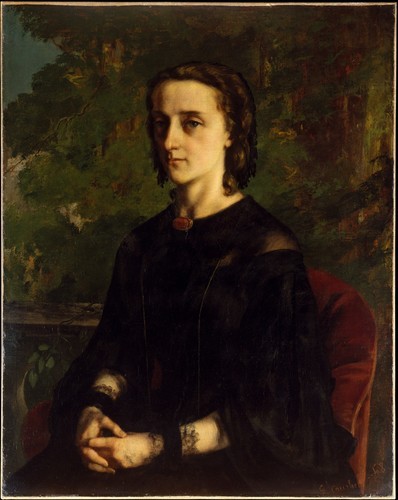
Madame Frederic Breyer (Fanny Hélène Van Bruyssel, 1830–1894), Gustave Courbet, 1858, European Paintings
H. O. Havemeyer Collection, Bequest of Mrs. H. O. Havemeyer, 1929
Size: 36 x 28 5/8 in. (91.4 x 72.7 cm)
Medium: Oil on canvas
https://www.metmuseum.org/art/collection/search/436000
5 notes
·
View notes
Photo

Madame Frederic Breyer (Fanny Hélène Van Bruyssel, 1830–1894), Gustave Courbet, 1858, European Paintings
H. O. Havemeyer Collection, Bequest of Mrs. H. O. Havemeyer, 1929
Size: 36 x 28 5/8 in. (91.4 x 72.7 cm)
Medium: Oil on canvas
https://www.metmuseum.org/art/collection/search/436000
4 notes
·
View notes
Photo

Madame Frederic Breyer (Fanny Hélène Van Bruyssel, 1830–1894), Gustave Courbet, 1858, European Paintings
H. O. Havemeyer Collection, Bequest of Mrs. H. O. Havemeyer, 1929
Size: 36 x 28 5/8 in. (91.4 x 72.7 cm)
Medium: Oil on canvas
https://www.metmuseum.org/art/collection/search/436000
4 notes
·
View notes
Photo
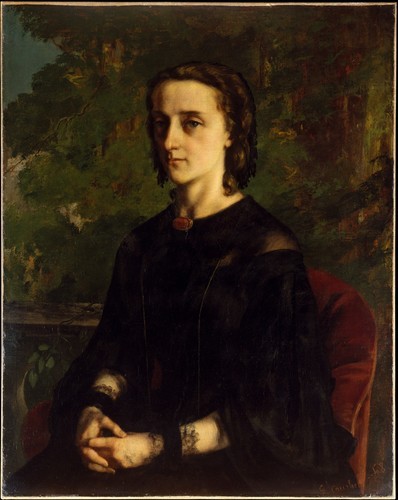
Madame Frederic Breyer (Fanny Hélène Van Bruyssel, 1830–1894), Gustave Courbet, 1858, European Paintings
H. O. Havemeyer Collection, Bequest of Mrs. H. O. Havemeyer, 1929
Size: 36 x 28 5/8 in. (91.4 x 72.7 cm)
Medium: Oil on canvas
https://www.metmuseum.org/art/collection/search/436000
4 notes
·
View notes
Photo
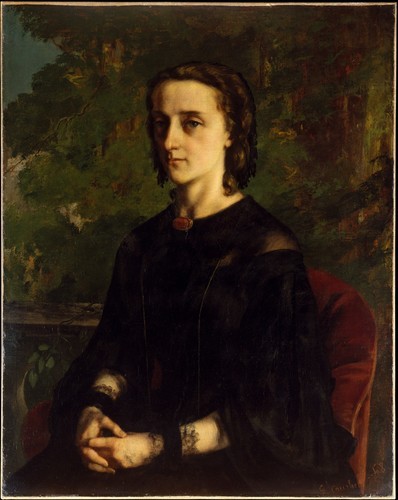
Madame Frederic Breyer (Fanny Hélène Van Bruyssel, 1830–1894), Gustave Courbet, 1858, European Paintings
H. O. Havemeyer Collection, Bequest of Mrs. H. O. Havemeyer, 1929
Size: 36 x 28 5/8 in. (91.4 x 72.7 cm)
Medium: Oil on canvas
https://www.metmuseum.org/art/collection/search/436000
1 note
·
View note
Photo

Madame Frederic Breyer (Fanny Hélène Van Bruyssel, 1830–1894), Gustave Courbet, 1858, European Paintings
H. O. Havemeyer Collection, Bequest of Mrs. H. O. Havemeyer, 1929
Size: 36 x 28 5/8 in. (91.4 x 72.7 cm)
Medium: Oil on canvas
https://www.metmuseum.org/art/collection/search/436000
1 note
·
View note